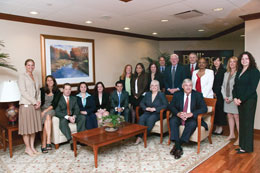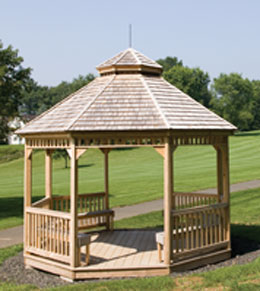|
Teeing up to write golf courses & clubs
Bollinger provides agents with a strong market for risks ranging from elite clubs to daily fee
By Edward O’Hare
When it comes to insuring golf clubs across America, Bollinger Insurance has been at the top of the leaderboard for years in this highly competitive specialty line and intends to stay right there—with a grip that Tiger Woods would die for.
“It comes down to providing the best product, appropriate pricing and risk management,” says Tom Marks, senior executive vice president, Club Programs, which also include tennis and city clubs. “And the ability to enhance and innovate coverages quickly to meet the changing needs of clubs, courses and golfers.”
To do that, Marks points to two main drivers. First, the program’s arrangement with its chief carrier—AIG/Lexington Insurance Co.—to function in a manner similar to an AIG branch office as a program administrator with authority to do all underwriting, rating, loss control and policy issuance. The second driver is a dedicated staff with more that 125 years of underwriting experience fully versed in the country club and golf course environment.
Started in 1983, the program initially concentrated on clubs in the New York metropolitan area before rolling out nationally to become the choice of more than 1,000 clubs and 125 associations, including the United States Golf Association (USGA). It has become a profitable and high profile sector for New Jersey-based Bollinger, one of the country’s 10 largest privately owned brokers. And it provides a lucrative niche for hundreds of independent agents and brokers who market it to private, semi-private and daily fee clubs.
In its portfolio, Bollinger has some well-known golf courses, such as Pine Valley, rated every year as the finest in the world; Baltusrol, where Phil Mickelson birdied the 18th to win the 2005 PGA Championship; and Winged Foot, where Mickelson double-bogeyed the 18th to blow the 2006 U.S. Open in June.
Then there’s Bollinger’s newest gem—Liberty National. Designed by former U.S. Open champion Tom Kite and architect Bob Cupp, the course sits on a one-mile stretch along the waterfront opposite Manhattan—with its 18th green less than 1,000 yards from the Statue of Liberty. No such thing as golf being “a good walk spoiled,” as one author called the game. Not at Liberty National, not with its spectacular view of the Statue, the Skyline, the Verrazano Narrows Bridge and 12-story cruise ships sailing by. The problem for golfers could be keeping their heads down from tee to green as well as taking a shot at the 623-yard monster 8th.
Well-known or not, Marks says all clubs in the Bollinger universe can, as its motto says, “Count on us for more.” That means benefiting from one of the most comprehensive policies available, which also features new additions such as identity theft, homeowners coverage for golf course communities and performance bonds for contractors, the latter enabling agents and brokers to be involved in construction and renovation of clubs and courses. There’s also 24/7 claims service, and a risk management component that includes on-site inspections and a steady stream of advisory bulletins.
With more and more attention being paid to safety, Marks says Bollinger has been out front with the use of programs such as GolfSafe of Manchester, Massachusetts. “Their medical professionals and experts will create an emergency response plan designed specifically for each club and reviewed annually,” says Marks, adding: “They also train staff, conduct mock drills and provide the necessary medical and on-course communications equipment needed at the club.”
One effort involves the installation of potentially life-saving devices—defibrillators—around the course, in the clubhouse and maintenance shop. Another is setting up lightning shelters within easy reach of golfers. The shelters bring to mind the lightning strike that may have started this effort. It involved Hall of Fame golfer Lee Trevino, who was knocked woozy during a tournament. Trevino swore that forevermore he would run off the course at the first sign of lightning, which now brings an immediate halt to play. But for added protection, the comical Trevino said he would now always carry a 1-iron because “even God can’t hit a 1-iron.”
Straight out, Marks will tell you that the club program has been his life. That should come as no surprise. He grew up in a well-known golfing family in New Jersey. His grandmother, Leila Robertson Marks, was known as the first of the “girl caddies” and “mother of American golf,” according to an article in the 1963 issue of Golfdom. In the early 1900s, she carried the bags of Willy Norton and Horace Rawlins, two famous golfers who played in what is believed to be the first professional tournament. With a purse of $150, the tournament was held on New Year’s Day in 1898 in Lakewood, New Jersey, as reported in The New York Times. Marks’ father, Art, was a club pro, capping his career at Rock Spring in West Orange, New Jersey.
As for Marks himself, if truth be told, he probably still has some sand in his shoes from his caddying days. Now he is a member of the Mendham Golf and Tennis Club and plays to a 10 handicap.
With more than 16,000 clubs and courses in existence countrywide, Marks says there are terrific opportunities for agents and brokers in this specialty—using Bollinger’s “user friendly” proposals. “Once we establish a relationship and realize that they have an appetite for this niche, we support them with a state-of-the-art product, knowledgeable and sophisticated underwriting and extremely fair pricing,” says Marks, adding, “If requested, we’ll join with them in proposals to clubs.”
Bollinger’s ability to provide a stable market has sustained its army of agents and brokers through the years and fostered a loyal and family-like relationship through which both have prospered. One such agent is David Lodwick, who thrives even in the heart of the hard market in South Florida. He attributes that to Bollinger’s consistency in its product and pricing and his own keen knowledge of the complex coverages for clubs. However, he voices concern about, among others, privately owned public clubs having the financial reserves to weather the next hurricane in the face of more modified coverages and higher deductibles.
“An agent needs to meet with the boards of these clubs and let them know that if they take a big hit exactly how much of the damage they’ll have to pay for,” says Lodwick, senior vice president, Insurance Office of America in Jupiter, Florida.
Bill Thomas, president of Carswell Insurance Services in Hilton Head, South Carolina, says, “The current market conditions in coastal areas are the worst I’ve ever seen.” But he counts on Bollinger’s ability to adjust to any conditions and stay in the market. “In turn,” says Thomas, “I’m able to provide the coverage up to the comfort levels my clubs need and want.”
For Mark Toral, vice president, Hub International Midwest Limited, “The golf club business is a tale of two marketplaces, with extreme variances in rate depending on where your club is located.” He also sees the vulnerability of privately owned public clubs in coastal areas—recalling a recent request for a quote from an East Coast club whose property premiums were increased from $50,000 last year to $250,000 for this year’s renewal. Clubs located in coastal areas face not only dramatically increased premiums, often for less coverage (i.e., limitations on wind, hail or flood) and higher deductibles, but the situation is compounded, he explains, by the fact that the secondary, deductible “buy down” markets for this exposure have become increasingly restrictive in their offerings.
Meanwhile, in the softer “non-cat”-prone marketplace, Toral sees a 180-degree difference in the rate environment, with rates being driven down as many carriers are showing big appetites for insuring this business.
All three agents believe the club business can be lucrative and through networking, lead to referrals. For agents and brokers seeking to develop this specialty, they stress the importance of learning the complex coverages different clubs require—to protect against the wide range of potential claims. The main challenge is finding carriers with proven track records in serving clubs.
Meanwhile the golf industry is also facing challenges as the building boom levels off. Many clubs are being sold to real estate developers as the land becomes more valuable than the business. That was the case in the recent sale of the three courses of Bay Tree Golf Plantation in Myrtle Beach, South Carolina—the center of the boom—for $20 million. But with more than 100 clubs in a 50- to 60-mile area, sales come as no surprise, either there or wherever the industry has overbuilt.
The greater challenge is to get more people to play golf and play more often. The National Golf Foundation (NGF) and other industry associations have an ambitious plan, Golf 20/20, to get 20 million more golfers by the year 2020. More new golfers could come much sooner from the thousands of instructional clinics being conducted for young people and from high schools which are now fielding teams. There are also high hopes that retiring baby boomers will take up the game. And there could be a growth spurt among women attracted by exciting young American golfers, including Michelle Wie, Paula Creamer and Brittany Lincicome, who are starting to light up the leaderboard on the professional tour. In the near term, the industry is trying to get more rounds from the 25 million core and occasional golfers by finding ways to make playing a more pleasurable experience.
How effective these efforts will be remains to be seen. But one thing is certain: Wherever golf is going, Tom Marks believes Bollinger will get there first—with new ways to insure clubs and their old and wonderful game. *
The author
Edward O’Hare is a freelance writer based in the New York City area. |
|
Click on image for enlargement |
 |
| |
Thomas N. Marks is Senior Executive Vice President, Club Programs, for Bollinger Insurance in Short Hills, New Jersey. |
| |
 |
| |
Bollinger insures more than 1,000 golf clubs and 125 golf associations, including the USGA. At right are patches for some of those associations. |
| |
 |
| |
The management team for Bollinger’s Club Programs includes (from left) Lucille C. Esposito, Senior Vice President/Operations; Thomas D. Walker, Vice President; Stephen J. Babcock, Senior Vice President; and Tom Marks. |
| |
 |
| |
John A. Windolf, CLU, CPCU, Chairman and CEO of Bollinger Insurance (standing fifth from right), appears with the Bollinger Club Programs team. |
| |
 |
| |
Bollinger encourages courses to install defibrillators around the course, in the clubhouse and maintenance shop. Additional recommended safety installations include UL approved lightning shelters, which incorporate multiple grounding straps (shown below). |
|


